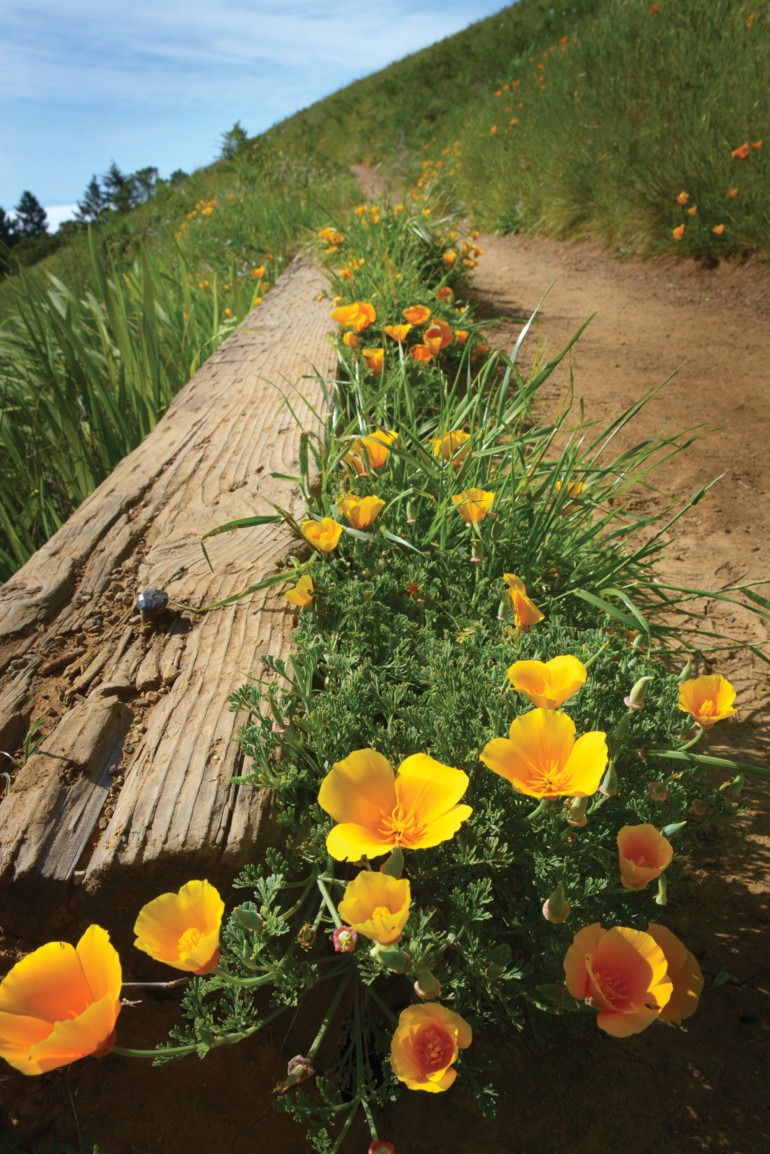For centuries our most creative poets — from Blake to the Bard — have paid homage to the fleeting beauty found in nature. To honor the fragile elegance they so often wrote about, here’s a seasonal guide offering places you too can see “Heaven in a Wildflower.”
There are dozens of flowers and ornamental shrubs to see along Marin’s trails. Here are just a few you might spot, starting with the ones to look out for in spring and summer.
April–June
Western Columbine/ Aquilegia formosa

Heather Cutoff Trail
When hiking near Marin’s numerous creeks, look out for this dainty but enchanting perennial. Brilliant red and yellow lanterns burst into bloom in the spring and then dangle from branching stems. Being adaptable to either moist or dry conditions, this California native is found up and down the West Coast. Growing your own columbine is simple: just provide water, and prune flower stalks to the ground in early spring. Let the flowers go to seed because they are proficient at self-sowing. Plus pollinators like bees and hummingbirds will love you for it.
Giant Chalk Dudleya/ Dudleya Brittonii
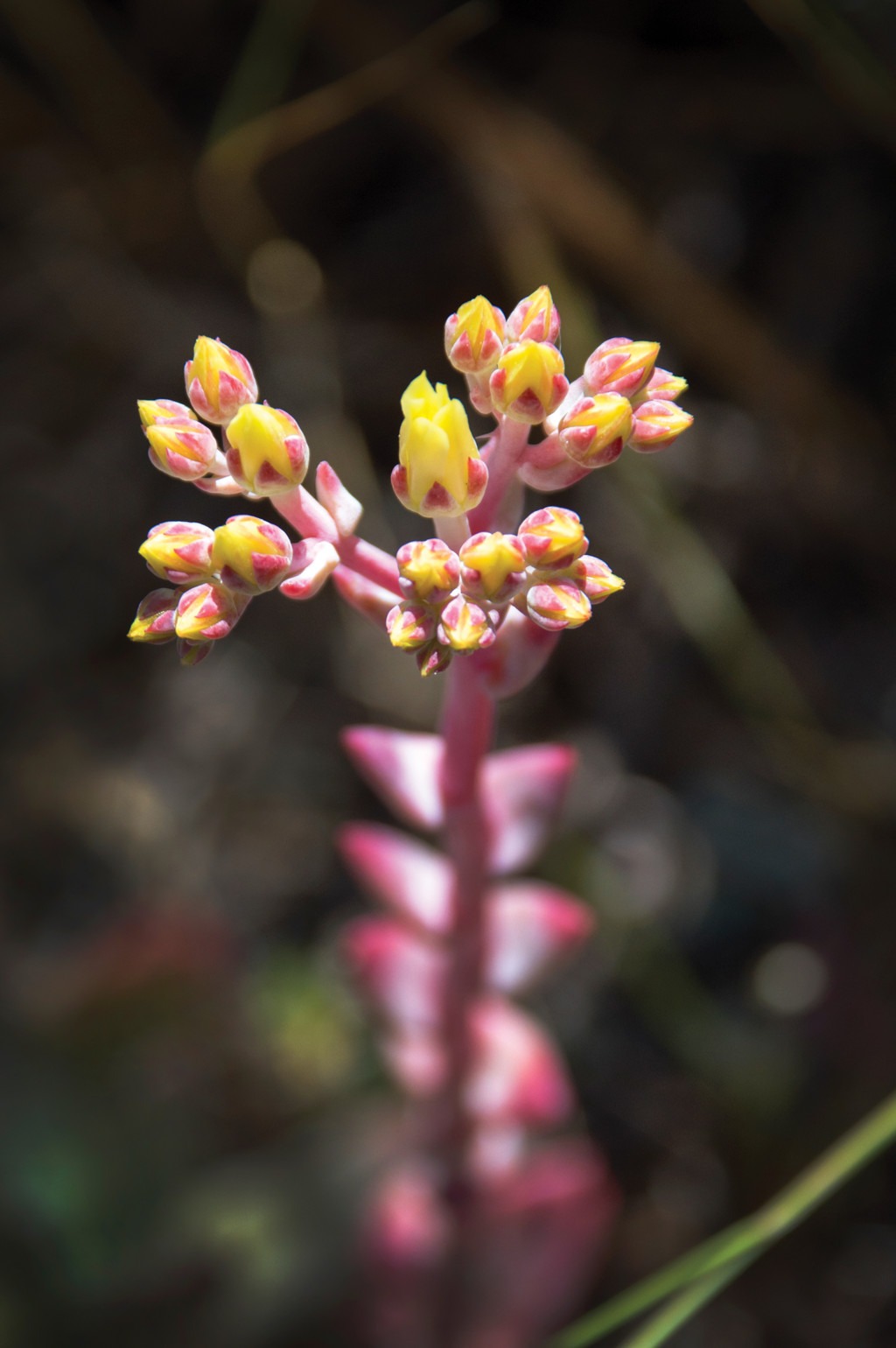
Heather Cutoff Trail
Yes, Marin has its own California native succulent, and this chalky blue-white gem is found on the county’s rocky slopes but is equally stunning in gardens. Arching red stems prop up urn-shaped blooms from hardy rosettes.
Miner’s Lettuce/ Montia perfoliata
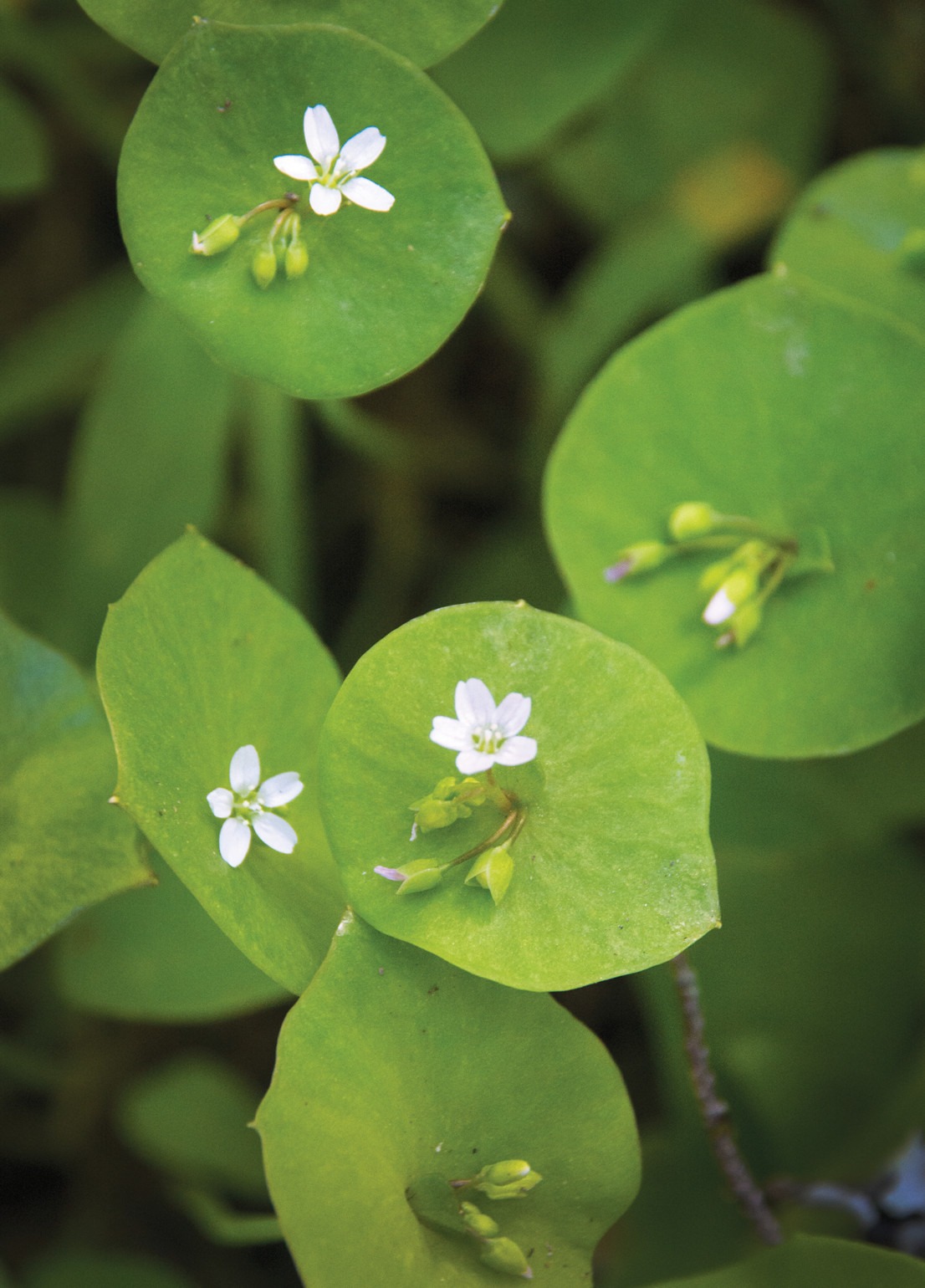
Old Mine Trail
Historians claim that miners during the Gold Rush ate this native lettuce to ward off scurvy. Luckily, scurvy is long gone and miner’s lettuce is still thriving. Found mainly in our shady woodland areas or sheltered under shrubs, the patches of water lily–like leaves are easily spotted on local trails.
Leopard Lily/ Lilium Pardalinum
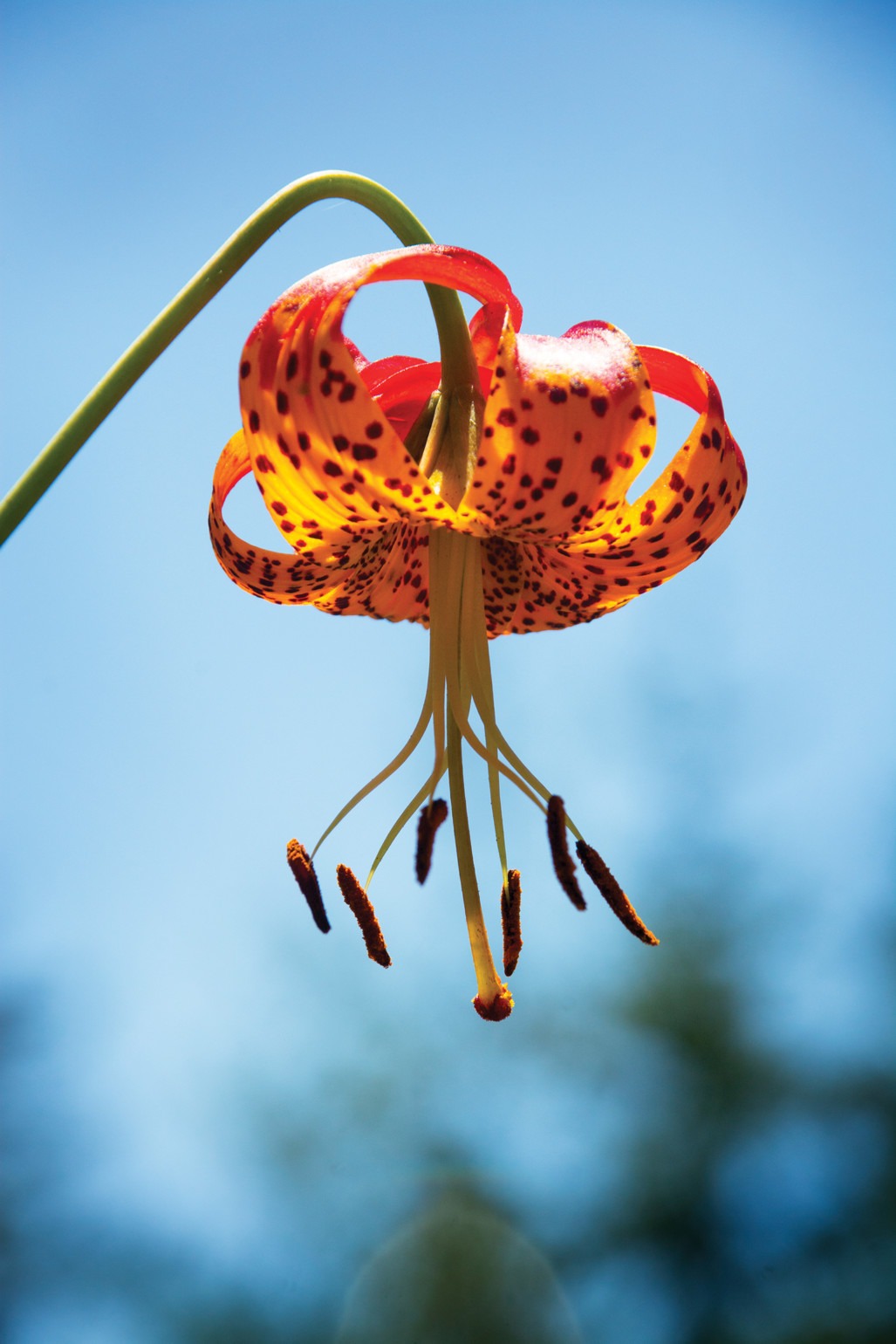
Panoramic Highway near Bootjack Campground
Reaching 4 feet tall, this elegant native bulb enjoys moist areas. The orange flowers are decorated with contrasting maroon dots and attract bees and butterflies. Folklore says that those who smell a leopard lily will develop freckles just like the plant, but since the flowers have no scent, any freckles you find were likely already there.
Blue Dicks/ Dichelostemma Capitatum

Matt Davis Trail
Naturalizing quickly, blue dicks are notably found in grassland areas recently disturbed by fire. With great speed and strong plastic straw-looking stems, these foothill flowers outgrow grasses and other wildflowers with ease. The corms of blue dicks were an important form of starch in the Native American diet.
July–September
Chaparral Pea/ Pickeringia Montana
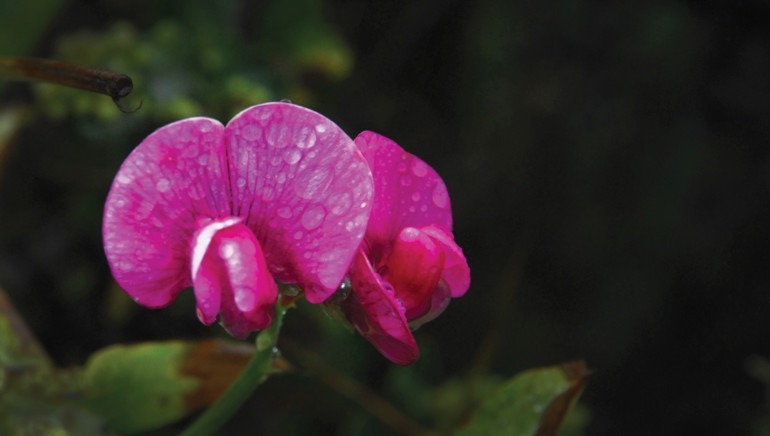
Somewhere along the Dipsea Trail
Surprisingly a legume with nitrogen-fixing qualities that aid in its survival on rocky or sandy soil, chaparral pea is a hardy shrub. Easily mistaken for French broom, this attractive bush with electric-pink pea flowers boasts wicked thorns. Black-tailed deer routinely and carefully pick out leaves and flowers from among the thorniness because chaparral pea provides an excellent protein source, despite the painful risk.
Coast Morning Glory/ Calystegia
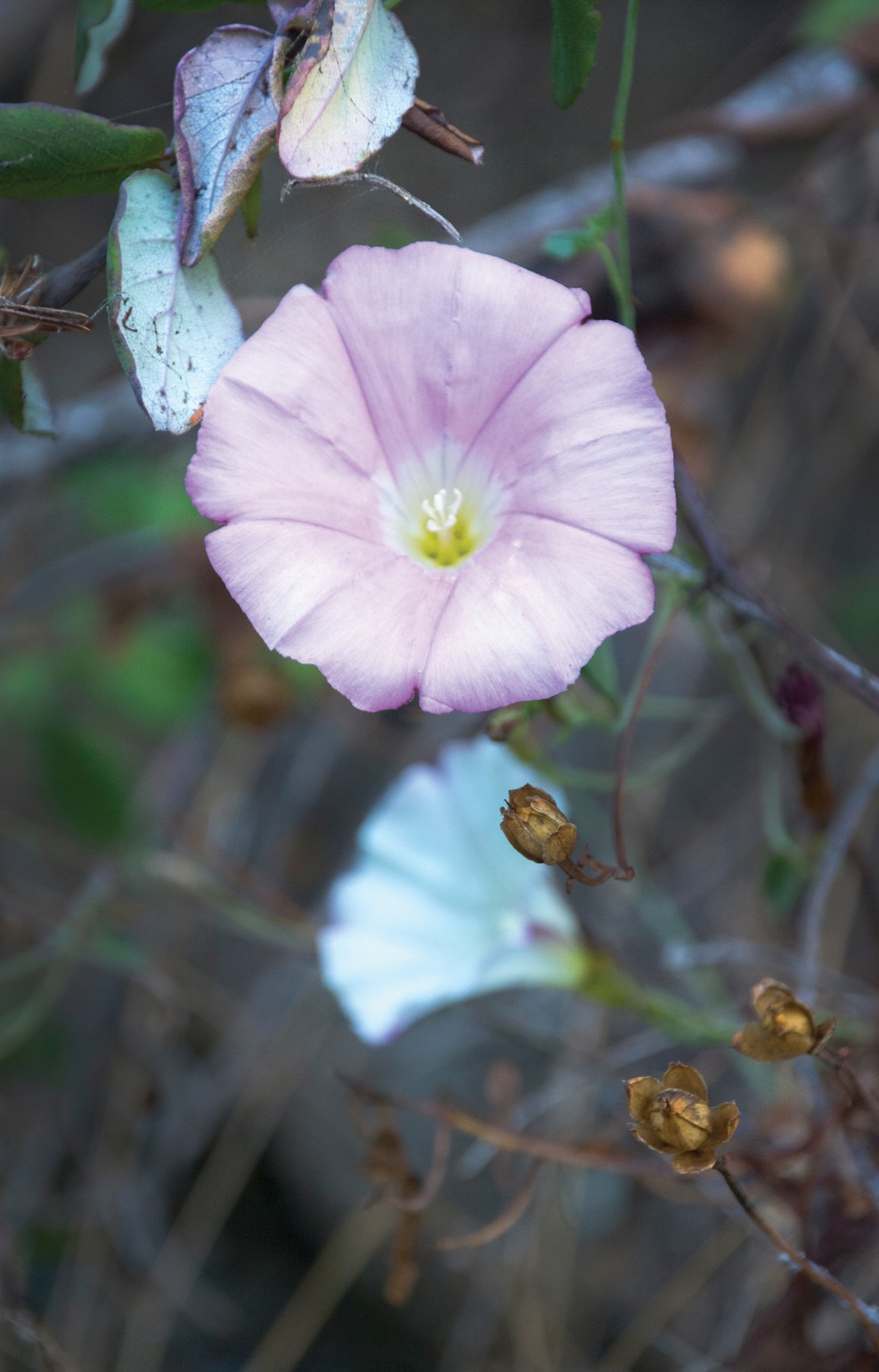
Troop 80 Trail
A lush native vine that is a force to be reckoned with, coast morning glory quickly scrambles up, over and through anything in its path. In garden settings, this vine can be considered a nasty nuisance despite its heartshaped leaves and sweet pale-pink cupped flowers.
Bush Poppy/ Dendomecon
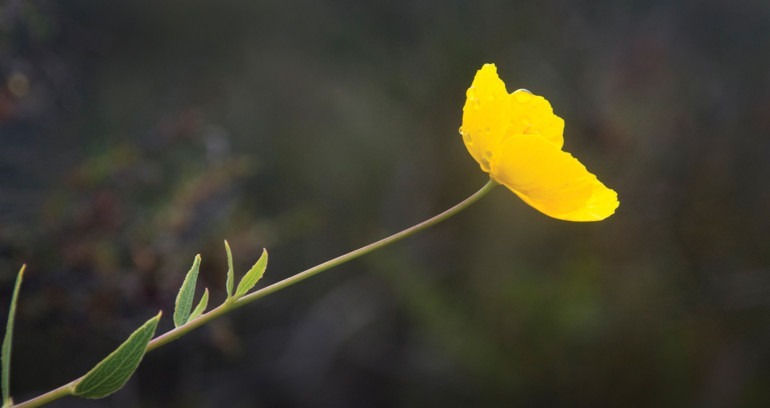
Old Railroad Grade Trail
Displaying showy butter-yellow blossoms on bluish-green leaves, this drought-tolerant native shrub quickly grows to 6 feet. A mature bush poppy can display dozens of blooms at once, making it easy to spot on hikes and sought after in nurseries.
Blue-Eyed Grass/ Sisyrinchium bellum
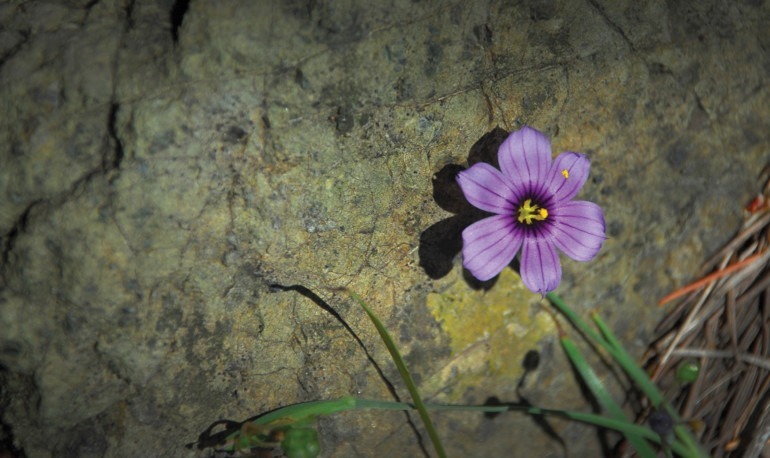
Troop 80 Trail
Attractive purple-blue flowers with yellow centers sprout from 1-foot-high grassy grayish clumps. An iris relative, this little native charmer likes sunny spots and was used medicinally by the Miwoks and Ohlone. Though blue-eyed grass’ flowers open for only one day, they are starry sights.
Gumweed/ Grindelia
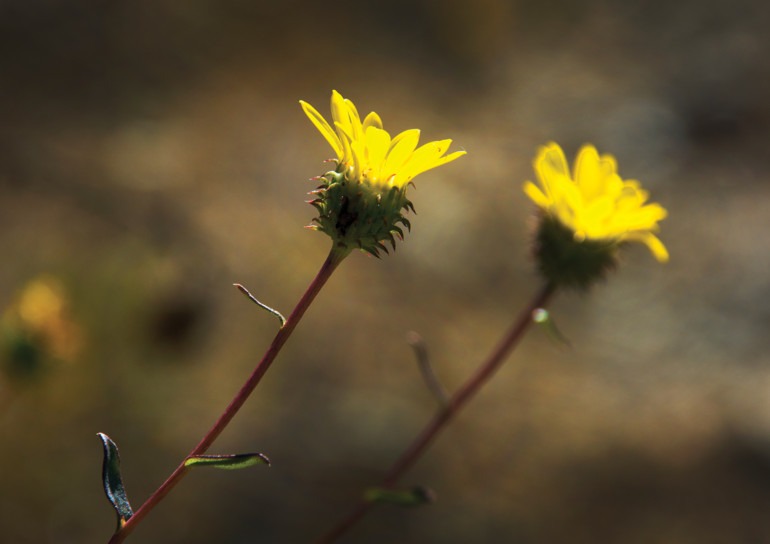
Matt Davis Trail
This is a native perennial resembling a petite sunflower. The flower buds contain copious amounts of gummy white sap that Native Americans creatively used as an adhesive but that also protects the blossoms from hungry predators. Gumweed is an excellent nectar plant as well.
October–December
Common Madia/ Madia Elegans
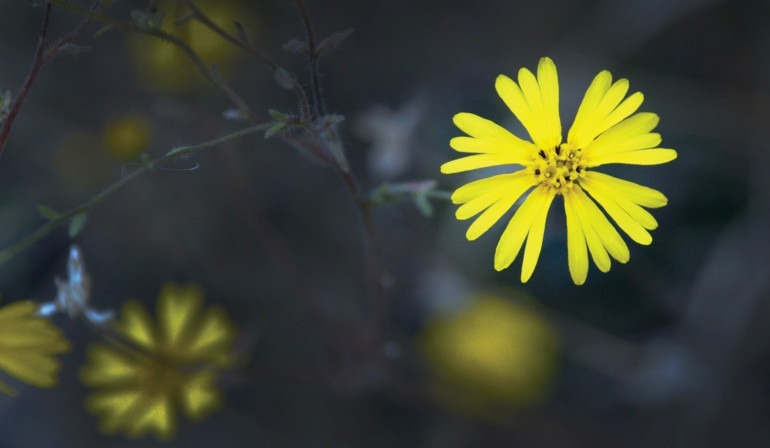
Laurel Dell
This is definitely not your ordinary yellow daisy. Madia is a 3- to 5-foot-tall annual wildflower that blooms when most other natives are slowing down. Two-inch showy bright yellow blooms are an important nectar source for bees and butterflies in the late seasons, and this plant reliably re-seeds itself. Deer leave this madia alone, perhaps because the leaves and stems are dressed with sticky, aromatic hairs. Some say the plant’s velvety foliage and flowers smell like pineapple.
Sticky Monkey Flower/ Diplacus
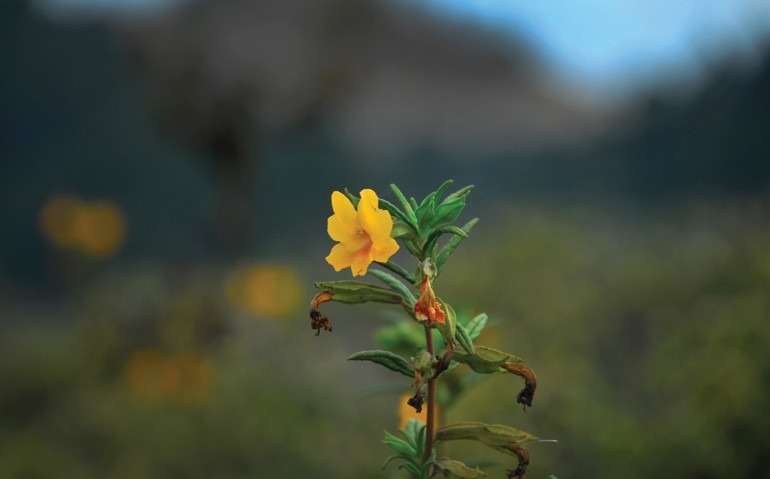
Matt Davis Trail
Bright trumpet-shaped flowers attract hordes of hummingbirds and humans alike. The name perhaps comes from the resinous leaves that feel sticky when touched. In dry, hot summers this plant begins looking bedraggled and then goes dormant.
Checkerbloom/ Sidalcea Malviflora
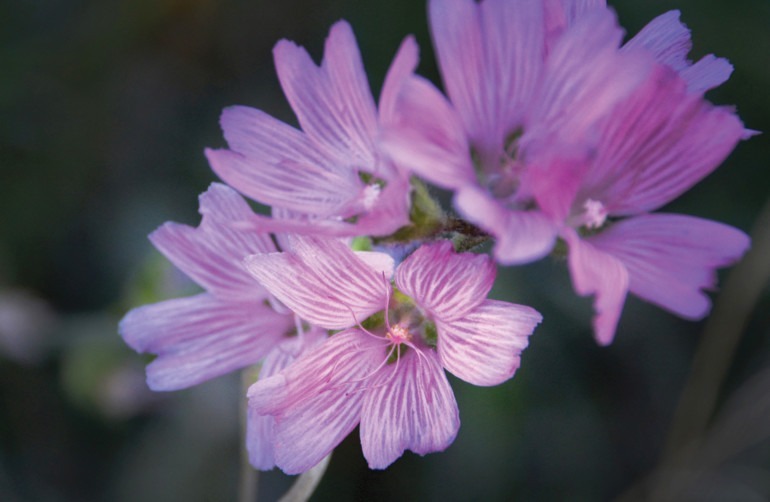
Cataract Trail
This is a prolific perennial native wildflower that spreads by seed and rhizome. Reportedly the Coast Miwok in Sonoma and Marin counties baked and ate the leaves, and the seeds were pounded into seed flour. When hiking, be sure to stop and admire the checkerbloom’s delicate pink display, because sources say it is mildly endangered.
Manzanita/ Arctostaphylos Species
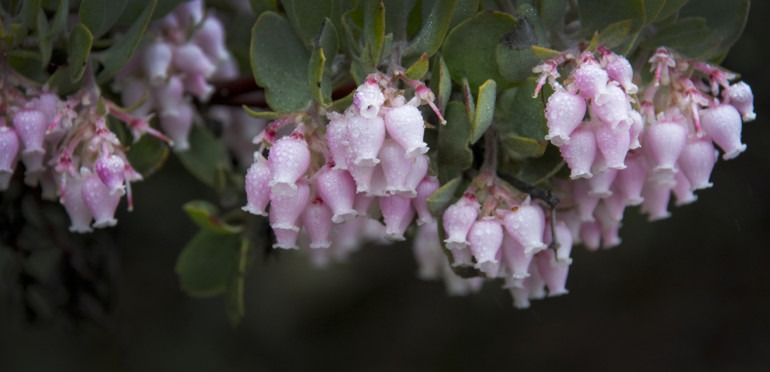
Rock Spring Trail
Popular for its shiny mahogany-colored bark, manzanitas also have urn-shaped flowers rich in nectar that sustains many forms of wildlife. The plant also has superior drought tolerance.
January–March
Silver Bush Lupine/ Lupinus Albifrons
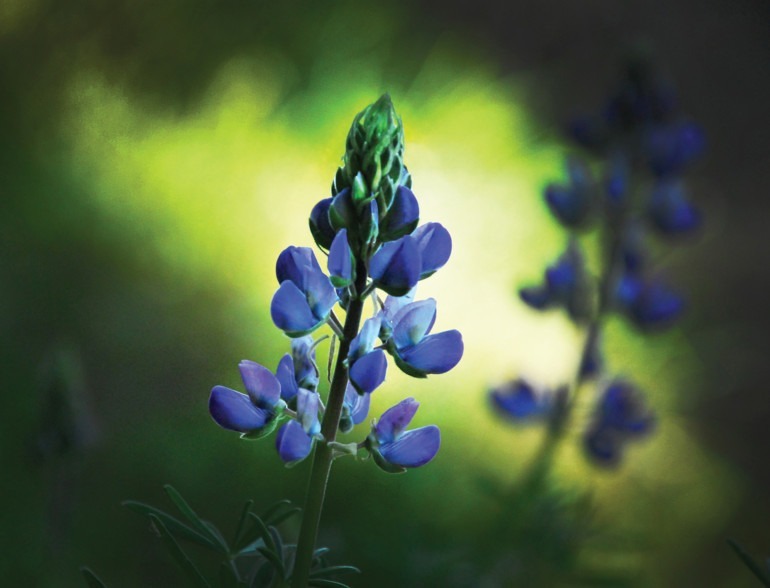
Matt Davis Trail near Stinson Beach
This California native shrub is famed for its fragrant purple-blue spires that summon bees and butterflies. In fact, the University of California’s colors of blue and gold were chosen because fields around the campus in 1868 were filled with blue lupines and California poppies. Lupines are also nitrogen-fixing legumes, so they restore soil when planted as a cover crop, and they were a staple in the Native American diet.
Milkmaids/ Cardamine Californica

Cataract Trail
Growing in a variety of habitats, milkmaids are one of the year’s first wildflowers to bloom. The white flowers proudly open during the day but close their petals as the sun goes down. Before a rain, milkmaids nod their heads to protect the pollen inside.
California Poppy/ Eschscholzia Californica
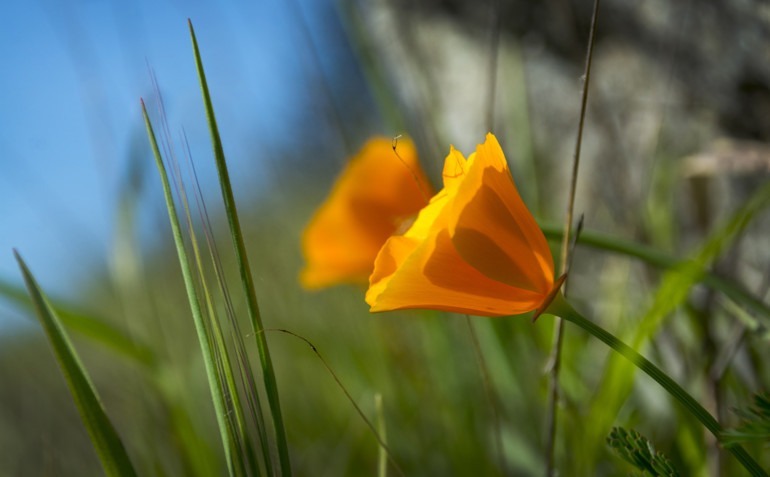
Old Mine Trail
What a sight when local rolling hills are ablaze with the satiny orange blooms of our state flower. California Indians revered the poppy as a food source and for medicine. A prolific re-seeder in nature, the California poppy is also successful in cultivated gardens when scattered in the fall.
Chaparral Clematis/ Clematis
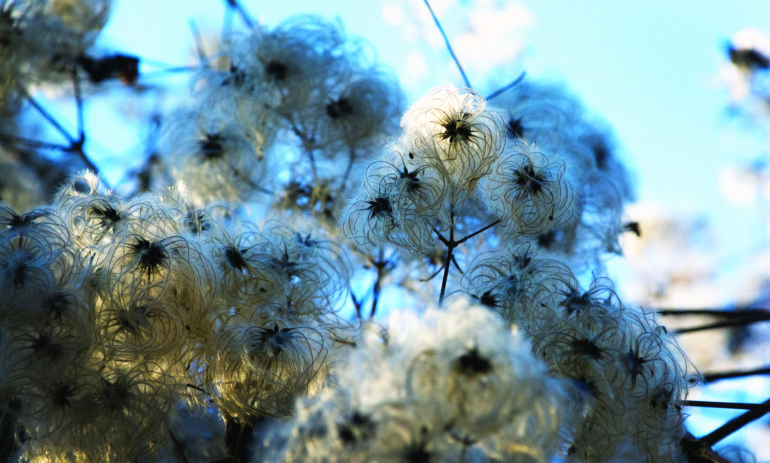
Muir Woods / Redwood Creek Trail
A deciduous native vine displaying a wealth of soft white flowers and then attractive smoky seed poufs. Clematis playfully scrambles over its neighbors while providing nectar for butterflies and attracting other pollinators with its fragrant flowers.
Indian Paintbrush/ Castilleja
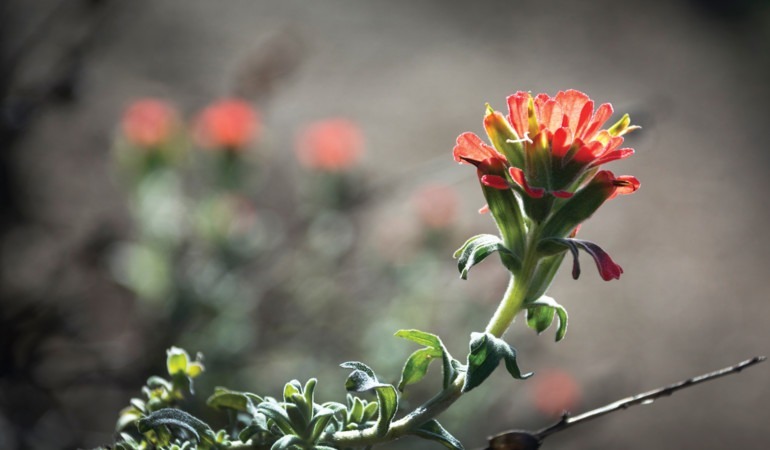
Matt Davis Trail
The name comes from the Native American legend: a young man intended to paint a sunset but couldn’t find the right color to match the sky. He asked the Great Spirit for help and received colorful paintbrushes, which were left on the land and re-bloomed as this flower.
More from Marin:
- 5 Wildflower Hikes to Try in Marin this February
- Marin’s Best Hiking Loops
- A Not-So-Hidden Treasure on Sausalito’s Hill 88
 Kier Holmes is a native, Marin-based landscape designer who works at M2 Design and Construction, for over 15 years, has artfully designed and created sustainable gardens that are dynamic year-round. She also writes for Gardenista, is an elementary school garden educator, a garden speaker for adults and leader of the Garden Club for kids at the Mill Valley Library. Holmes readily admits that she is a nerd about all things plant-related, and can geek out on a dinner-plate dahlia like nobody’s business. Her natural habitat is among flowers and her hands are almost always dirty.
Kier Holmes is a native, Marin-based landscape designer who works at M2 Design and Construction, for over 15 years, has artfully designed and created sustainable gardens that are dynamic year-round. She also writes for Gardenista, is an elementary school garden educator, a garden speaker for adults and leader of the Garden Club for kids at the Mill Valley Library. Holmes readily admits that she is a nerd about all things plant-related, and can geek out on a dinner-plate dahlia like nobody’s business. Her natural habitat is among flowers and her hands are almost always dirty.

